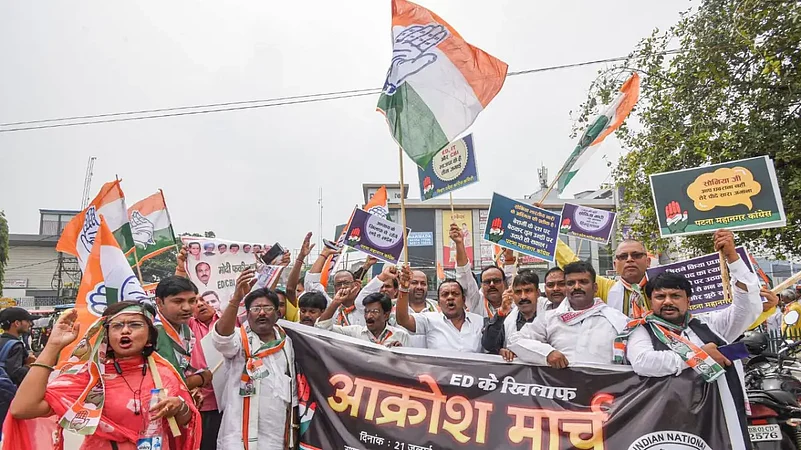Caught in the eye of an Enforcement Directorate probe, the Gandhis, Sonia and Rahul, appear to have taken a leaf out of Mahatma Gandhi’s resistance playbook.
Ever since the party was relegated to opposition benches nearly a decade back, the Congress has been accused of not pulling its weight as the country’s primary opposition party when it comes to taking on the ruling Bharatiya Janata Party over key contentious issues like inflation, repeated fuel hikes, the rising communal tide, etc.
But with the ED now pressing hard against the Gandhi clan, namely interim Congress president Sonia Gandhi and her son Rahul in the National Herald money laundering case, the party has now resorted to satyagraha; a non-violent civil resistance tool originally used by Mahatma Gandhi to great effect in the freedom struggle.
The grand old party has now hit the streets across the country in protest against what its leaders have alleged as “misuse” of central government agencies to silence and side-line the opposition and critics. Rahul Gandhi and several Congress leaders were detained for several hours in the national capital on Tuesday, during a protest march against ED’s summoning and subsequent grilling of Sonia Gandhi.
The philosophy of satyagraha— in literal terms meaning holding on to the truth—was first articulated on ground by Mahatma Gandhi in South Africa to confront violence, injustice and to oppose racist laws in that country.
During the course of India’s struggle for freedom, Gandhi also used Satyagraha, as a movement to confront the colonial brutality through passive resistance, civil disobedience, and non-cooperation—all of them non-violent methods.
Over time, Gandhi’s satyagraha ideal found takers across the world with Martin Luther King Jr., Nelson Mandela, Lech Walesa, Vaclav Havel, Benigno Aquino Jr adopting a unique methodology to get their point across to those in power.
India too threw up several tenacious non-violent movements against discrimination, injustice, marginalization, and environmental degradation. Babasaheb Ambedkar’s relentlessly fought against the evils of the Indian caste system using the same principles.
So did the Chipko movement, a non-violent socio-ecological campaign to protect trees and forests slated for state-backed felling or the Narmada Bachao Andolan, which protested against dam projects across the Narmada river. India’s post-independence history is replete with examples where Gandhi’s satyagraha provided an effective medium of resistance.
In most recent memory, the relentless and sustained non-violent protests by India’s farmers, eventually forced the National Democratic Alliance government at the Centre to roll back controversial farm laws.
Besides the signature of non-violence, these socio-political movements also have one thing in common: all of them sprung out of the need to question authority in order to protect the stakes of a particular community subjected to injustice or cruelty at the hands of state machinery.
In current time, 13 opposition parties including the Congress have slammed ED for its political overplay at the behest of the BJP, calling it a “relentless campaign of vendetta against its political opponents and critics through the mischievous misuse of investigative agencies.”
In a joint statement, the opposition parties also resolved to “to continue and intensify our collective fight against the anti-people, anti-farmer, anti-
Constitution policies of the Modi sarkar that is destroying the social fabric of our society.”
Political analysts however believe that Congress, which is now vehemently protesting against the ED’s action of its top leaders, the Gandhis, has been largely been missing in action, especially at crucial junctures, when strong opposition resistance was imperative.
Taking a dig at the Congress’ protests, a BJP leader said, “This is not ‘satyagrah’ but ‘duragrah’ against the country, its laws, and its agencies,” adding that “this is also a duragrah for protecting the family which has ‘pocketed’ the party’s assets worth thousands of crores of rupees.”
BJP national president JP Nadda has also slammed the Congress’ satyagraha.
“Congress protests not 'Satyagrah(a)', but an attempt to hide the truth. They are protesting to protect a family, not the country. Gandhis required to answer the investigation agencies, but they think they are above the law,” Nadda said.
According to a political analyst, the ED investigation into the National Herald case, the agency’s sustained interrogation of Rahul Gandhi for 50 hours over five days, and his mother, Sonia's ongoing questioning is probably meant to “create and embed a narrative of long-time Congress malfeasance in the public mind in the runup to the 2024 general election.”
Pushed to the wall now, Congress has pulled the ‘satyagraha’ strategy out of its hat. But whether the campaign is aimed at salvaging the Opposition’s fate or just the political fortunes of the party’s High Command, the Gandhis, remains to be seen.


























